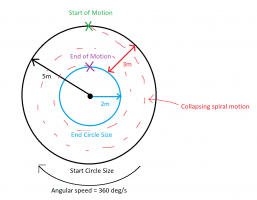Hello,
I am currently working on a computer program to move on object undergoing circular motion in a spiral of decreasing radius. I hope this is illustrated clearly below (forgive me but it is a sketch and thus not precise in scale):

The scenario is as follows:
1. The object starts angular motion at the green "X"
2. The object starts orbiting at an angular speed of 360 deg/s
3. The object immediately undergoes the collapsing spiral when it starts moving from the green "X"
4. The spiral decreases at a linear (constant) rate
5. The object reaches the end of motion at the purple "X"
From this scenario, I can see that the linear distance covered is 3m. I also know that the angular speed (or velocity) is constantly changing during the spiral, since the radius is changing. The challenge I have is to control the exact number of spirals that occur between the green "X" and purple "X".
I have tried to tackle this challenge in multiple ways, but none of them are precise and I can never get an exact number of spirals - if I am aiming for say 2 spirals, sometimes it will overshoot and sometimes it will undershoot. I think my problem is that I am cobbling together code without understanding the underlying math, so I would really appreciate if anyone can advise how to achieve this in a precise and reliable way that is mathematically sound. A few of my initial thoughts are:
1. The linear distance must come into the equation somehow
2. I know what the start and end angular velocities are since I know the radii of the circles - this may be of some use
Some may consider this more of a physics challenge but any help would still be greatly appreciated!
Thank you
I am currently working on a computer program to move on object undergoing circular motion in a spiral of decreasing radius. I hope this is illustrated clearly below (forgive me but it is a sketch and thus not precise in scale):

The scenario is as follows:
1. The object starts angular motion at the green "X"
2. The object starts orbiting at an angular speed of 360 deg/s
3. The object immediately undergoes the collapsing spiral when it starts moving from the green "X"
4. The spiral decreases at a linear (constant) rate
5. The object reaches the end of motion at the purple "X"
From this scenario, I can see that the linear distance covered is 3m. I also know that the angular speed (or velocity) is constantly changing during the spiral, since the radius is changing. The challenge I have is to control the exact number of spirals that occur between the green "X" and purple "X".
I have tried to tackle this challenge in multiple ways, but none of them are precise and I can never get an exact number of spirals - if I am aiming for say 2 spirals, sometimes it will overshoot and sometimes it will undershoot. I think my problem is that I am cobbling together code without understanding the underlying math, so I would really appreciate if anyone can advise how to achieve this in a precise and reliable way that is mathematically sound. A few of my initial thoughts are:
1. The linear distance must come into the equation somehow
2. I know what the start and end angular velocities are since I know the radii of the circles - this may be of some use
Some may consider this more of a physics challenge but any help would still be greatly appreciated!
Thank you
